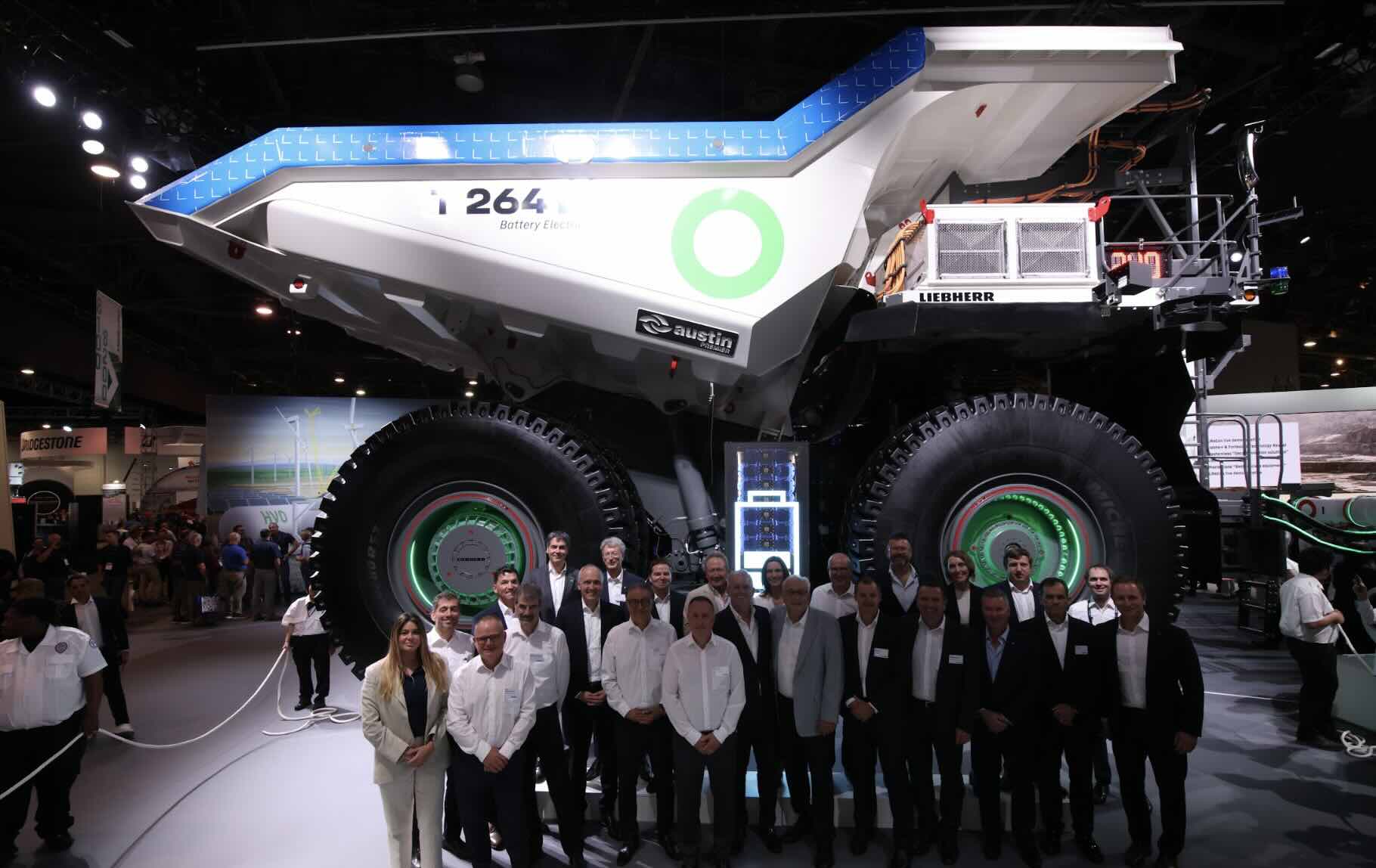- cross-posted to:
- [email protected]
- cross-posted to:
- [email protected]
Reminds me of an article I read a year or more ago at this point about a mine using a similar EV truck. It would regenerate so much electricity during a round trip that the batteries would be pretty much fully recharged.
Edit: Found it:
https://www.greencarreports.com/news/1124478_world-s-largest-ev-never-has-to-be-recharged
Introducing the latest battery chemistry: very high rocks!
The 6 MW chargers will be used to charge the huge 1.9 megawatt hour batteries that drive the power systems for the massive 240 tonne battery electric haul trucks. It says it will be able to do that in just half an hour.
Removed by mod
Unfortunately, it’s vital for steel production since it’s a reducing agent and used in blast furnaces. There are other options out there but they are pretty far from being implemented AFAIK
They’re investing in “green metal”, using their own renewable generation to produce hydrogen.
Whether or not it works out is another matter, but he (Andrew Forrest) seems to believe in it and is willing to put his money where his mouth is.
The future is very clearly electric.
Honestly, I was mildly apprehensive about posting this here, since mining is generally frowned upon by environmental orientated groups. However, mining is central to renewables, whether we like it or not. It’s also been around as long as humanity. I’m not defending it’s environmental issues by any stretch. I’m very much for responsible mining and more regulation.
However, electrification of mining vehicles is a win. In some cases, it’s not going to make much difference on net emissions, but in other cases, where to have a greener grid, it most certainly will. If you have a network of solar or wind power generators nearby, it’s a no-brainer. In some cases, old waste rock piles or TSFs can be progressively reclaimed and green power generators and installed on them. While electrification doesn’t solve emissions or env. Impact on the whole but it gives the opportunity to harness other sources of power than just fuel
Think about it like this:
The current price for a megagram of forest carbon is about 25 bucks. The contract for that is 25 years. So about a buck per year per megagram.The average megagram of fossil fuels CO2 was laid down in the Carboniferous. So call it 100 mya for dipshit math. Average temperate forest might do 2 megagrams per hectare per year. So to sequester a megagram of forest carbon for the time equivalent of fossil fuels carbon, you would need to set aside apx 50 million hectares for the time equivalent sequestration benefit. Which would mean that to get the time equivalent sequestration benefit from forest carbon, you need to set aside 50 million hectares. Per megagram. Which is just preposterous. It also implied that the stored value of a non-emitted megagram of fossil fuels carbon is about 50 million dollars. Which is to say if we believe that a megagram of forest carbon stored for 25 years is worth 25 bucks, we should by extension believe that keeping a megagram of carbon from being emitted from fossil fuels is worth 50 million bucks. Obviously none of this is really true but it points to the absurdity of sequestration and the importance of not emitting more carbon from fossil fuels, in any manner. Right now solar and bev are the most obvious, straight forward, And demonstrated to be effective ways to get there. We might literally be in a path to a world of practically free electricity in some places at certain times of day.
Also big electric truck go bzzzz.
*(these are all approx numbers and math; I’m in the shitter and not looking up anything for the haters)
The thing that we don’t consider in the current models is storage time when it comes to cost/credits. There’s no distinction between storing new carbon and old carbon.
I think your point still holds water in that storage is not the answer, but reduction is
Some people are considering time. Also these fine folks.
Once you put time into the equation, the highlights the absurdity of valuing any form of sequestration while not valuing avoided emissions.
Especially for heavy machinery. Electric motors have instantaneous torque that far exceeds industrial diesels and weight actually helps secure loads and allows massive regenerative brakes. So it can get jobs done faster and cost less. Also unlike private cars, you’re not going to use it outside of work hours so you just charge it when your shift is over.
A 240 tonne battery? That’s almost 240 tonnes less payload. They should make one that runs on hydrogen or ammonia.
No the truck is 240T I think
Ah you’re right. Assuming an energy density of 160 Wh/kg that’s still almost 12,000kg. That much hydrogen contains about 400MWh.
The theoretical energy density assumes no cryogenic tanks, no plumbing, and no fuel cells. Also the production, storage, and transfer of Hydrogen as a fuel is INCREDIBLY inefficient.
Okay, but this application only requires 1.9MWh on board. That would be about 57kg of hydrogen. The required capacity would actually be less since the hydrogen refuel time should be significantly less than recharging a battery. Anyway, I just doubt very much that 11,900kg storage vessels and fuel cell would be required. There’s simply less dead weight in a hydrogen vehicle as well as better performance and less externalities associated with battery production and disposal/recycling.
As for the efficiency of hydrogen production and delivery, it shouldn’t matter. We need to produce it anyway for emissions free steel and fertilizer production. The real problem is that we don’t have enough emissions free energy production, which isn’t one that battery vehicles or storage facilities solve. The current paradigm is one of deficit in order to create a market and I think battery storage unfortunately facilitates that. Instead, we need to build out capacity so that there’s almost always a surplus of electricity with the extra getting diverted to hydrogen production. It should be rare that the process is reversed to turn hydrogen back into electricity for the grid. That hydrogen is currently too expensive is the result of bad policy, which BEVs just reinforce.
Then your looking at almost an order of magnitude increase in fuel costs and a related increase in operating costs rather than savings.
Why would the operating costs be higher?
Because green hydrogen is expensive, and the more realistic projections estimate it will remain so to at least 2050.
If we use the CRU estimations, which notably are a trade group very much betting on green hydrogen adoption, we should be expecting at best a price of $3 dollars a kg in the distant future, with the current best price being more in the range of $6-$7 dollars a kg. With a 65% effective fuel cell that works out to the hauler getting its electricity at 28 cents a kwh with the possibility of going down to as low as 14 cents a kwh in future.
For reference, the average industrial electricity rate in 2023 was 8 cents per kwh, and Lazard puts the cost of utility scale solar at between 3 and 9 cents a kwh if a mine wants to roll their own. Wholesale Diesel fuel has ranged from about $2 to about $2.8 a gallon so at a reasonable 38% efficiency you get about 14 to 20 cents per kwh.
Not as bad as I expected offhand thanks to the current low cost of industrial green hydrogen, but your still looking at spending a massive amount of money for big platinum catalyst fuel cells and electric powertrains all so that you can spend thirty percent more on fuel than you do currently, as compared to using the grid directly for fifty percent less than you currently spend.
And we haven’t even mentioned that these things are going up and down a steep grade all day, so not only do you want massive batteries anyway so you can recharge on the way down, but you need them because unlike a small FCEV where it’s fuel cell is nowhere near large enough to output full power (and as such is only used to charge the battery) you do actually need to be able to sustain full power for the whole trip up.
TLDR: Industrial electricity is far cheaper than Diesel, let alone the more expensive green hydrogen. Hydrogen may be able to compete on a one or one level with Diesel in the far future, but given the upfront cost of the kit you might as well go all the way so you’re saving money over the long term.
I meant apart from the hydrogen fuel costs. It’s not obvious to me why the labor and maintenance costs of hydrogen powered mining vehicles wouldn’t be greater than that of the battery powered versions and the attendant charging/battery swapping equipment.
Mostly its the fuel costs adding to operating costs, but dealing with a cryogenic and highly flammable liquid/gas and all the related fluid handling, pressure regulators, and piping necessary is always going to be more labor and repair intensive than just expanding and directly charging the battery the vehicle needs to have anyway.
I’m getting one of those chargers installed at home next week. The giant mushroom cloud you might see is nothing to worry about.








